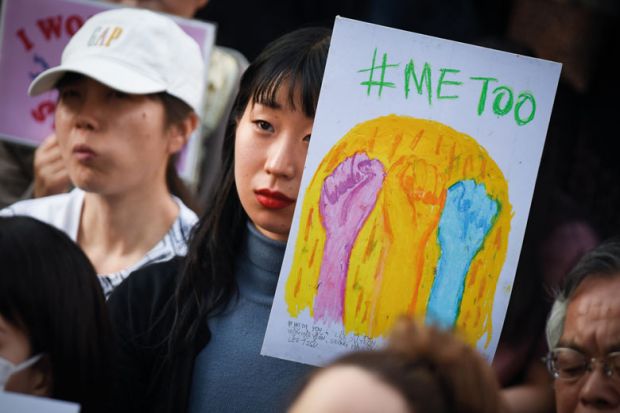Japanese universities’ slow adoption of clear language and rules on sexual harassment shows that the issue still is not taken seriously in the country’s academy, scholars say.
Japan’s Ministry of Education, Culture, Sports, Science and Technology (MEXT) recently directed universities to check the disciplinary records of prospective faculty before hiring them – a move scholars say reveals that the sector is woefully behind the times.
The MEXT guidance came after a report found that only 37 per cent of national universities in Japan required faculty members to report their history of disciplinary punishment for sexual violence when hiring them. Some 40 per cent of universities did not clearly indicate that students could be victims of sexual violence, according to the report.
Akira Arimoto, emeritus professor of education at Hiroshima University, said the figures point to “a large lack of recognition” of the issue in Japanese higher education. He said he believed that many universities might not be troubled by the statistics, with some probably finding them “reasonable, owing to their traditional conservative way of thinking”.
Professor Arimoto said institutions needed to stop relying on the individual ethics of staff and faculty members to prevent incidents of sexual harassment, and instead outline clear boundaries and punishments for inappropriate behaviour.
“Universities in the national, private and local sectors [must] have explicit language on this in their rules and guidelines,” he said.
Chisato Kitanaka, director of the Rape Crisis Centre in Hiroshima and an associate professor at Hiroshima University, agreed.
She noted that rules requiring Japanese higher education to take action against sexual harassment followed the passage of similar measures for all employers in the year 2000.
“Although the law was intended for sexual harassment in the employer-employee relationship, [MEXT said that] schools and universities should establish measures so that students are also covered,” she said.
But despite the issue having been in public policy for more than 30 years, the law on the issue remained “weak”, said Dr Kitanaka, with Japanese universities largely left to their own devices.
Campus resource: Despite positive steps, much remains to be done on sexual misconduct
There have been more cases of universities taking a harder line on academic bullying, but there has been little progress – and, in some cases, a step back – on sexual harassment.
Dr Kitanaka noted that, in recent years, universities had started to use their own formats for recruiting faculty members – something she said had led to the accidental elimination of the “award and punishment” column that used to commonly feature in the forms, and where faculty would previously be required to list infractions.
“[The disappearance of this column] made it virtually impossible to ascertain the history of disciplinary actions” taken against potential hires, she said.
Policies at universities tended to vary, with differing levels of attention to the issue, she said.
“In practice, many universities try to obtain information informally on whether the person they intend to hire has had previous problematic behaviour.”
While she welcomed the notice by the ministry to universities to “clearly include” this information in their policies, Dr Kitanaka said she thought the government’s other guidance was “out of line with the actual situation” at universities.
“The instruction to ‘distinguish between sexual harassment and sexual violence and clearly state in the university regulations the criteria for disciplinary action’ shows that the MEXT official thinks the term ‘sexual harassment’ could be misunderstood as a light act,” she said.
She called for more clarity overall, as well as greater understanding by government officials of the situation at universities.
“The guidance is largely unhelpful, except for the part about improving the format of the recruitment forms,” she said. “It is my impression that the ministry officials do not know what is happening at universities and what is needed.”
Register to continue
Why register?
- Registration is free and only takes a moment
- Once registered, you can read 3 articles a month
- Sign up for our newsletter
Subscribe
Or subscribe for unlimited access to:
- Unlimited access to news, views, insights & reviews
- Digital editions
- Digital access to THE’s university and college rankings analysis
Already registered or a current subscriber? Login




